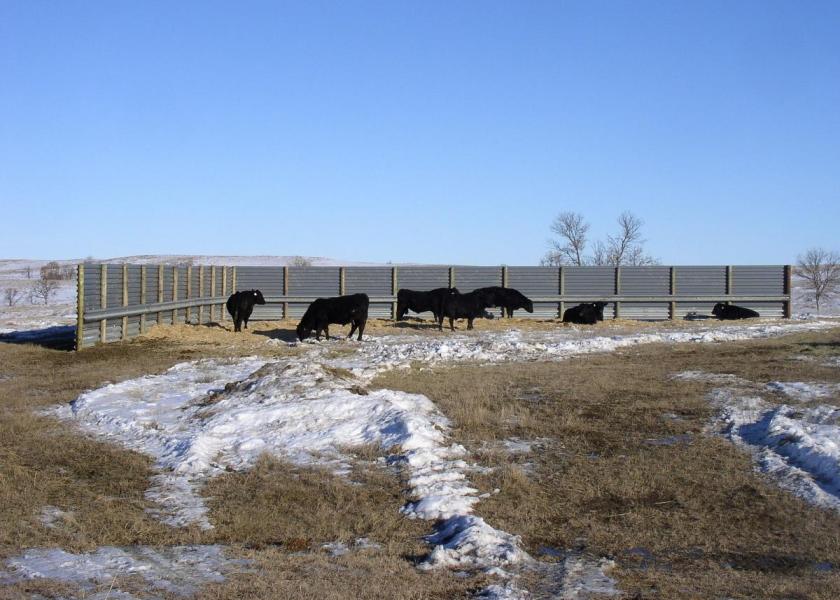Don’t Discount the Need for Vitamin A and E in Beef Cows This Winter

Written with contributions by Adele Harty, former SDSU Extension cow/calf field specialist.
Poor quality of forage fed to cows in late gestation can present health challenges not only for the cows but for the calves they’re about to give birth to. Drought conditions or poor haying conditions during the previous growing season can lower quantities of those forage’s essential nutrients, such as Vitamin A and Vitamin E. The ability of producers to provide supplemental Vitamin A and E for their animals can also be affected by manufacturing or other supply problems that change the way mineral manufacturers include such vitamins in their products.
Regardless of the previous year’s growing conditions, forage vitamin levels are not something cattle producers should take for granted. Supplying sufficient Vitamin A and Vitamin E to cows in late gestation is important every year, and the price of the supplement should not be a limiting factor.
Calf Vigor And Immunity
Both Vitamins A and E are plentiful in green forages, but tend to be much lower in hay and winter range and continues to decline as the fall and winter progress. While textbooks will point out the dramatic effects of Vitamin A and E deficiencies in cattle (congenital eye problems, white muscle disease in calves), these overt problems are not as common as the more ambiguous effects on calf vigor and immunity.
Marginal Vitamin A deficiencies in calves cause lower responsiveness of immune cells in the body and a breakdown of the protective functions in the gut and lungs.
Likewise, Vitamin E is important in protecting body cells from damage (e.g. from infections) and also plays a role in maintaining immunity. The result of deficiencies in these vitamins can show up as decreased vigor and an increased susceptibility to illness.
Supplementation Is Important
The importance of these vitamins to the newborn calf is contrasted by the fact these vitamins do not cross the placenta in high enough amounts to meet their requirements. Calves must obtain sufficient levels through colostrum right after they’re born. This means producers should focus on the vitamin status of the cow prior to calving to ensure sufficient levels in the colostrum.
Cows’ livers can store about a 4-month supply of Vitamin A, which can be depleted if green forage is not available. Vitamin E is not sufficiently stored in the body, although there is some disparity among experts and the literature on this point.1,2 If cows are supplemented with these vitamins continually during the non-grazing season, body storage becomes a less-important issue.
Actions To Take
Pregnant cows and heifers should be supplemented with 30,000-100,000 IU/head/day of Vitamin A and 50-100 IU/head/day of Vitamin E when green forage is not available. Even high-quality stored forage should not be depended upon to supply sufficient Vitamin A or E. Some studies indicate benefits to using higher levels of supplementation,3,4 while others do not. Higher vitamin supplementation rates do not appear to be risky from a toxicologic standpoint.4
Cattle producers and veterinarians sometimes rely on injections of Vitamin A to help increase levels in the liver. An injection of 1,000,000 to 1,500,000 IU per head can boost liver levels, but may need to be given monthly if other supplementation is not provided. A single injection two weeks prior to calving has been recommended to help the cow overcome a drop in the body reserves of these vitamins around the time of calving.
Right Product, Right Timing
If cows are not deficient in these vitamins, injections do not appear to be useful. Reports of adverse reactions (abortions, shock) have been reported in late-gestation cows receiving vitamin injections in conjunction with vaccines such as scour shots. Producers should consult their veterinarians regarding specific products and the timing of their use.
Injections of Vitamin E and A to newborn calves can also be considered; however, this should not be considered a substitute for proper vitamin supplementation in the cow’s diet, nor for ensuring timely and sufficient colostrum consumption in the calf.
Even in years when forage growing conditions are good, producers should not plan on skimping on vitamin supplementation for their cows during this – or any other – winter.
References:
1Frye TM, Williams SN, Graham TW. Vitamin deficiencies in cattle. The Veterinary clinics of North America Food animal practice 1991;7:217-275.
2N Hidiroglou NC, AS Atwal, ER Farnworth, LR Mcdowell. Comparative vitamin E requirements and metabolism in livestock. Annales de Recherches Vétérinaires 1992;23:337-359.
3Corah L. Understanding basic mineral and vitamin nutrition. The Range Beef Cow Symposium XIV 1995.
4DSM Nutritional Products AG. Vitamin Nutrition Compendium: Vitamin E.







